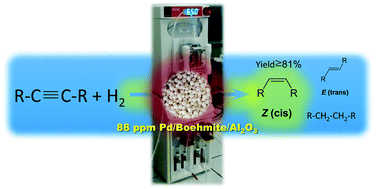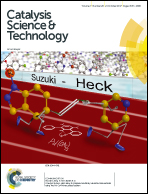Selective hydrogenation of alkynes over ppm-level Pd/boehmite/Al2O3 beads in a continuous-flow reactor
Abstract
A ppm-level Pd/boemite catalyst has been prepared over 3 mm alumina beads and used for the selective hydrogenation of alkynes in a continuous-flow reactor with two modes: closed-loop and flow-through. The flow rates of the alkyne solution and hydrogen gas are critical factors in the control of conversion and selectivity. In closed-loop mode, over 90% selectivity to alkene was achieved at over 90% conversion of phenylacetylene (PA) and 2-butyne-1,4-diol (ByD) in closed-loop mode, whereas diphenylacetylene (DPA) gave only 83% selectivity to (Z)-stilbene. The maximum outputs obtained for the hydrogenations of 22 mM PA, DPA and ByD at 60 °C, with 10 vol% H2 gas bubble at atmospheric pressure in the concurrent flow, were 37.8, 37.5 and 47.0 mmol min−1 g−1 Pd, respectively. In flow-through mode, the optimal H2 flow percentage in the concurrent flow was 44–45 vol%, while the optimal H2/ByD molar ratio was 1.6–1.7 for both concurrent flow rates of 0.4 and 0.7 mL min−1. 90% selectivity to 2-butene-1,4-diol was achieved at over 90% ByD conversion. The maximum output was 25.2 mmol min−1 g−1 Pd. Palladium leaching from the catalyst was evaluated in n-hexane and ethanol under the flow conditions over 100 hours of hydrogenation.



 Please wait while we load your content...
Please wait while we load your content...